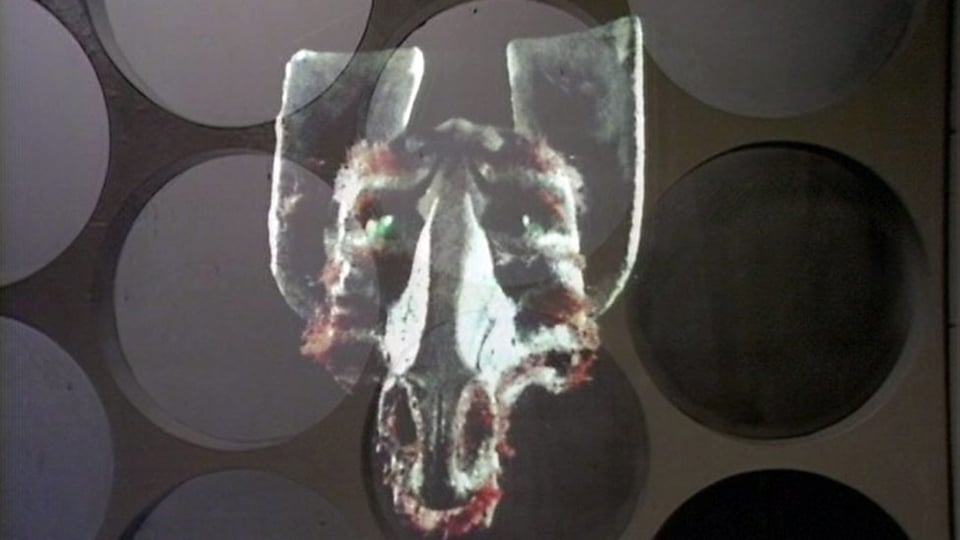Pyramids of Mars
“Spirits of ancient Egypt. Hung on the telly. Hung on the telly.”
I enjoy a good coincidence. There are times when I feel like coincidence is the operating system of the universe. So much of my life, of every life I’m aware of, really, hangs by threads of coincidence. There are children out there who only exist because I long ago encouraged someone to migrate across the country and come and work where I did, meaning they met their now partner and eventually reproduced. But I only knew that person because they were related by marriage to someone I met on my first day of senior school. Thus those children in some sense owe their existence not just to decisions I made when I was eleven years old, but also to exams I did when I was ten. Exams which, in those days, were used to sort children in various parts of Britain into different kinds of schools, based on their perceived academic ability when they were ten.
Now, when I was ten, my next door neighbour’s Dad had Pyramids of Mars on VHS, and once I’d finished with his copy of Revenge of the Cybermen, he remembered that he’d neglected to mention that there was, in fact, a second Doctor Who videotape in the house. So I borrowed that too and watched it, and like Revenge of the Cybermen I loved it, and so watched it on a loop until I could copy it and hand it back.
Pyramids of Mars begins, oddly enough, with a slightly fiddly coincidence; companion Sarah Jane (Elisabeth Sladen) seems to put on period appropriate clothing at a whim before the TARDIS arrives in 1911. This feels like an artefact of the rushed rewriting of the story by script editor Robert Holmes, whose reworking of a Lewis Griefer script seemingly set in a Museum is credited to the mysterious pseudonym “Stephen Harris”. There are other wrinkles throughout the script that would be counted against the story by fans if it were a lesser production, or perhaps had it been made in another decade.
Because this is an extraordinarily vivid story. The first three episodes feel dominated by their relative luxurious location filming allowance, which has the effect, as it always does in 1970s Doctor Who, of making the programme seeming higher budget than it is. The period setting has a similar effect. Props, costumes and set elements pulled out of BBC storage at minimal outlay, both look better and cost less than The Ark in Space or Planet of Evil. It’s enough to make you wonder why, as it extracted itself from the its enforced “near contemporary Earth” format, Doctor Who didn’t avail itself of historical settings more often. If juxtaposition is the heart of Doctor Who, and I firmly believe it is, then a historical setting combined with a science fiction threat offers amongst the quickest routes to realising that onscreen, and perhaps Pyramids of Mars’ success is in part due to the confidence with which it travels along it.
I’ve written about Pyramids of Mars, its first VHS and its “censorship” history recently. I don’t intend to repeat anything (much) from that article here. But I will say that you should watch Pip Madeley’s video about the cuts made to the story to make that compilation. But something else I play with there is the idea that Pyramids is part of a “core canon” of Doctor Who stories. Not in terms of continuity, but in terms of taking up permanent residence in the collective fan brain. Of representing, more or less, F R Leavis’ idea of a canonical text. When we talk about the Holmes / Hinchcliffe era presenting “Gothic Horror” what we really mean is Pyramids of Mars and a couple of Holmes' stories that seem to imitate its success. It stands for the era for which it represents, really, only around a third.
Nevertheless, it’s one of those stories which would constitute the coldest of takes if a fan of old money Doctor Who declared it to be their very favourite. It’s the story that features in Russell T Davies’ Queer as Folk. Its “visiting an alternative present to see that adventures in history have consequences” scene was something he intended be reprised in The Unquiet Dead (2005) and finally managed to do so in The Devil’s Chord this year.
It’s a brilliant sequence, easy to dismiss as padding[^1], but also answering a key question a certain kind of viewer might have.1 Watching it on VHS as a child I found it, if not exactly frightening, then shocking and haunting, and it seemed more relevant than it should have done; the first dozen of so times I saw it I heard Tom Baker’s muttered line “Nineteen Eighty Sarah, if you want to get off” as “Nineteen Eighty Seven, if you want to get off”.

The idea of being destroyed by something which only becomes aware of you thanks to your own imperial adventurism is one of the many ambiguities of “imperial anxiety”, a turn-of-the-twentieth-century idea of the British empire being subsumed from without, and is key to numerous horror and adventure works of the era, including many that implicitly see an element of justice in that destruction. (E.g. Conan Doyle’s Lot 249, as invoked splendidly in last year’s BBC adaptation.)
Related notions run through the story. Sutekh violates the TARDIS in the same way Marcus Scarman has violated ancient tombs - and in successive scenes. The latter, indeed, causes the former. Later, the priory, the childhood home of the Scarmans, is violated by Sutekh and his cult, and ultimately destroyed by events, burned to the ground. Sutekh might not destroy the world, but he destroys the world of the Scarman family.
What binds this together is that not only does the Doctor have to defeat Sutekh in order for the near future in which the UNIT stories take place to exist but, because the priory is on the site on which UNIT HQ will later be built, the destruction of the priory itself is a matter of, if not historical inevitability, then of getting history back onto the track that Doctor Who and Sarah already know.
Because while Marcus Scarman brings the destruction of his entire family and their home upon himself through his grave-robbing, the Doctor’s role is to protect the innocent. In the case of Laurence Scarman and Dr Warlock, personally innocent but perhaps implicated by blood2 and class, he fails. But he manages to save the future, the innocents as yet unborn, and all his own past adventures. Punishment can only go so far.
Pyramids is also an interesting example of how Robert Holmes’ own writing is simultaneously consistently anti-colonial (e.g. Carnival of Monsters (1973), even elements of The Sun Makers [1977]) while also unselfconscious in its use of iconography and stereotypes drawn from the imperial era pulp fiction he loved.
One feels a version of William Blake’s snarking compliment to Milton about his characterisation of Satan in Paradise Lost (1667) that he was “of the devil’s party without knowing it” because he was a poet, and poets - at least in Blake’s view always are. Holmes was too good at sketching in characters in a handful of lines to render them as cliches, even when pastiching work that would.
So while Dr Warlock is motivated by admirable human concern for his friends, Marcus and Laurence, he is also indecently patronising to Namin, something not ameliorated by Namin being inarguably a villain. Because Warlock is simply patronising, he’s also objectively wrong about a number of things. The letter from Marcus Scarman is not forged. Namin does have the owner’s permission to be in the house, and Warlock’s contempt for Namin’s religion as “superstitious balderdash” is partially undercut by the fact that Namin is correct about Sutekh’s existence and power. Even if he’s wrong about what Sutekh wants, and thus another kind of victim himself.
The implication that Osiran rule in Egypt was its own kind of colonial project helps ameliorate the story’s own trading in the essentially racist Von Daniken notion that the culture of ancient civilisations we don’t code a “white” could only have been achieved with extraterrestrial help. Although in this case Holmes’ main inspiration seems to be the 1970s Viking probes’ photography of the Martian surface,

Like its real life counterparts, Pyramids of Mars casts a long shadow; it was repeated a little over a year after its original transmission, with a 60m edit going out on 27th November 1976. That not only made it one of the stories that the original viewership could enjoy more than once, it was also seen by 13.7m viewers. The largest audience figure Doctor Who has ever reached on television in either century.3 It shown at the BFI in 1983 and has been released on home media in various forms and additions repeatedly since in, including-but-not-limited to, 1987, 1994, 2004, 2011 and 2013.
A novel sequel, The Sands of Time by Justin Richards, was one of the highest selling of the Virgin Books Doctor Who ranges of the 1990s4 and interregnum era Doctor Who novelist Lawrence Miles wrote a series of prequel audios featuring Sutekh, again played by Gabriel Woolf5 who also returned to the part for a “comedy skit” included on the Pyramids of Mars DVD and played a character (“The Beast”) who may or may not in some sense be Sutekh in The Impossible Planet (2007).
None, as far as I recall, have ever engaged with the most intriguing dead end that results from Pyramids rush drafting. It’s entirely unclear how and why Sutekh appears in the TARDIS at the story’s opening. There’s a faint implication it might be another version of the warning that Laurence Scarman’s marconi-scope receives. But there are other possibilities; one long time fan theory is that it’s a Sutekh, trapped in a time corridor at the end of the story, intersecting with the TARDIS as it travels back in time from 37,1666 to 1980, before being dragged to 1911. Making the whole story a sort of loop.
Which brings us bang up to date. Because I’ve had to make some alterations to this post since I finished it. Because, as you inevitably know, Sutekh has been revealed as “big bad” of the current series of Doctor Who, voiced again by Gabriel Woolf and he seems to have possessed the TARDIS. That’s something which happened between me finishing this post and scheduling it, and there’s now a new (third?!) re-edit of the serial on iplayer, so Doctor Who’s modern audience can take it to their hearts. Or perhaps weigh them against it, in the traditional Osiran fashion.
As I said, I do enjoy a good coincidence. Even an inconvenient one.

Which is, of course, the reasoning behind Davies’ desire to reprise it. ↩
“Brother.. as Horus was brother to Sutekh” as Marcus mutters in the serial’s most chilling scene. ↩
Without the dubious advantage of ITV being on strike. ↩
How much that is to do with it being on shelves the month the 1996 TVM was on television and on VHS on those same shelves is a consideration. ↩
I was not involved, although full disclosure, I have worked on other things made by their producers. Nevertheless, my endorsement here is simply one of a paying punter. You can get them from here. ↩
The date on the grave at the start of the previous story, Planet of Evil. Okay, maybe it’s a non human date system, but the Doctor also says they’re “thirty thousand” years after their intended arrival date at UNIT HQ. ↩